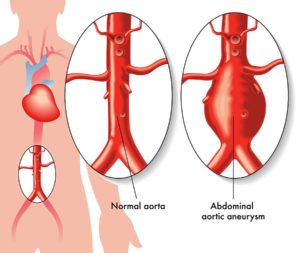 An abdominal aortic aneurysm (AAA or triple A) is an enlargement of the abdominal aorta. Undiagnosed and untreated, an abdominal aortic aneurysm usually enlarges and sometimes ruptures. According to the Society for Vascular Surgery, approximately 200,000 people in the U.S. are diagnosed with an abdominal aortic aneurysm each year. A ruptured AAA is the 15th leading cause of death in the country, and the 10th leading cause of death in men older than 55. A ruptured abdominal aortic aneurysm can cause massive internal bleeding, which is usually fatal. Approximately 8 out of 10 people with a rupture either die before they reach hospital or do not survive surgery. Because many people have no symptoms, getting screened for an abdominal aortic aneurysm is extremely important.
An abdominal aortic aneurysm (AAA or triple A) is an enlargement of the abdominal aorta. Undiagnosed and untreated, an abdominal aortic aneurysm usually enlarges and sometimes ruptures. According to the Society for Vascular Surgery, approximately 200,000 people in the U.S. are diagnosed with an abdominal aortic aneurysm each year. A ruptured AAA is the 15th leading cause of death in the country, and the 10th leading cause of death in men older than 55. A ruptured abdominal aortic aneurysm can cause massive internal bleeding, which is usually fatal. Approximately 8 out of 10 people with a rupture either die before they reach hospital or do not survive surgery. Because many people have no symptoms, getting screened for an abdominal aortic aneurysm is extremely important.
The Aorta
The aorta is the largest artery in the body and is responsible for carrying oxygen rich blood from the heart to every organ and tissue. It takes on different names depending on the portion we are talking about, but it is important to note that there is only one aorta.
There are three main portions of the aorta.
- The ascending aorta – where it rises from the top portion of the heart.
- The aortic arch – where it begins to curve downward.
- The descending aorta – where it passes downward and through the length of the body.
The portion of the aorta that passes through the chest is known as the thoracic aorta, and the portion that extends from approximately the “v” at the center of the rib cage to the lower abdomen is the abdominal aorta. This is the portion we are concerned with when talking about an abdominal aortic aneurysm.
Aneurysm
An aneurysm is a weakened and ballooning area of an artery. They generally start small and grow larger over time, some quickly. Because of the risk associated with rupture, it is extremely important that an aneurism is diagnosed as early as possible.
Abdominal Aortic Aneurysm
The abdominal aortic aneurysm is the most common type of aortic aneurysm, with the most common causes being a buildup of plaque in the artery (atherosclerosis), and/or hardening of the arteries (arteriosclerosis).
Other risk factors/causes include:
- Genetic predisposition/heredity
- Age 50 or over
- Smoking (past or present)
- Hypertension (more than half of patients with aneurysms also have hypertension)
Signs & Symptoms
As previously mentioned, there are often no symptoms associated with an abdominal aortic aneurysm, but symptoms, when present, can include:
- Generalized abdominal pain
- Sensation of fullness
- low back pain unaffected by movement
- Sudden low back or abdominal pain radiating to the side or groin
- A pulsating mass in the umbilical area
If you are experiencing, or have experienced, any of the above symptoms, or possess any of the above-mentioned risk factors, please have your screening done as soon as possible.
Your Screening & What to Expect
The good news is that your abdominal aortic aneurysm screening is non-invasive, fast, easy, and painless. The test we will be conducting is known as an abdominal ultrasound. You will be asked to lie on your back with your shirt pulled up to chest level. The technician will put ultrasound gel on a handheld device called a transducer and move it across your abdomen. Measurements of your abdominal aorta will be taken and recorded. The results will be sent to you, and you are strongly encouraged to share these with your primary care physician. If an aneurysm is detected, the size is the main factor in determining the next course of action. Measured in centimeters, an abdominal aortic aneurysm is usually diagnosed for a measurement greater than 3cm. There is a high likelihood of rupture for aneurysms greater than 5.5cm, and surgical repair is recommended for all aneurysms larger than 6cm (all at the discretion of your primary physician).
Regardless of size, if you are a smoker, you will be encouraged to quit immediately. You will be tested for hypertension and placed on an anti-hypertensive if necessary. If you have a pre-existing diagnosis of hypertension, you will be encouraged to remain compliant with your medication regimen and dietary recommendations. All at the discretion of your primary physician. You can also expect your physician to require regular follow-up screenings in order to track any growth of the aneurysm. If you are experiencing, or have experienced, any of the above symptoms, or possess any of the above-mentioned risk factors, please have your screening done as soon as possible.
